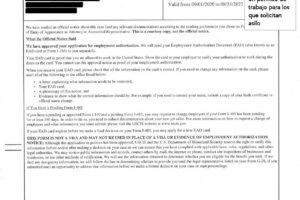Proof of INS status

Today, I want to address a crucial topic for many of us here: proof of status with the INS, now known as USCIS, and how this document plays a critical role in our lives as immigrants.
What is the INS Proof of Status?
First, let’s clarify what proof of status means. This term refers to the documentation that validates our legal stay in the U.S., either as conditional permanent residents or in the process towards citizenship.
In the past, the Immigration and Naturalization Service (INS) was in charge of these matters. However, since 2003, USCIS (U.S. Citizenship and Immigration Services) has taken the reins, along with other agencies such as ICE (Immigration and Customs Enforcement) and CBP (Customs and Border Protection), all under the wing of the Department of Homeland Security.
Importance of the Condition Voucher
For those of us who aspire to permanent residency or U.S. citizenship, complying with the requirements established by the USCIS is an unavoidable step.
This process includes, among others, the filing of Form I-751 for those with conditional permanent residence.
This document is vital to prove that our marital relationship, the basis for conditional residency, is legitimate and continues to be valid.
How to Obtain and Maintain your Proof of Condition?
Eligibility Requirements:
To be eligible to file Form I-751, you must be a conditional permanent resident who has been married to a U.S. citizen or permanent resident for at least two years.
In addition, you are required to have lived in a bona fide marital union with your spouse during that time and be admissible for permanent residence in the US.
Necessary Documentation:
When submitting your Form I-751, you must include:
- Copy of your conditional permanent resident card.
- Copy of your marriage certificate.
- Proof that you have lived with your spouse for at least two years.
- Evidence of a bona fide marriage.
- Proof of your eligibility for permanent residence.
Process and Processing Time:
Processing time may vary, but the USCIS can take up to 18 months to process your application. You will receive a receipt notice with a case number to track the status of your application. You may also be scheduled for an interview as part of the process.
If your application is approved, you will be notified in writing, and the conditions of your residency will be removed, granting you permanent residency.
What Happens if the Application is Denied?
If your application to remove the conditions on your residency (Form I-751) is denied by USCIS, it is important to understand your options and the steps you can take. While a denial can be discouraging, it is not necessarily the end of the road. Here I explain in detail what you can do in this situation:
Right to Appeal
- Notification of Denial: You will receive a written notice explaining the reasons for the denial. It is crucial to read this notice carefully to understand the specific reasons for the decision.
- Appeal: You have the right to appeal the decision to the Board of Immigration Appeals (BIA). The denial notice will include instructions on how to file an appeal, including the form to use (usually Form EOIR-29) and the deadline for filing, which is generally 30 days from the date of the decision.
- Preparing your Appeal: To successfully appeal, you will need to present strong arguments and additional evidence to counter the reasons for the denial. This may include additional documentation demonstrating the authenticity of your marriage or addressing any concerns about your eligibility for permanent residency.
Submit a New Application
In some situations, it may be advisable or necessary to file a new application for permanent residence instead of, or in addition to, an appeal. This could be the case if:
- Changes in your Status: If your status has changed significantly since you filed your Form I-751 (for example, if you have remarried a U.S. citizen) and you now qualify under a different category.
- New Evidence: If you have acquired significant new evidence that was not available or was not presented in your original application, filing a new application may be a viable option.
Tips for Handling a Denial
- Legal Consultation: Seriously consider the assistance of an immigration attorney. A professional can provide you with a detailed assessment of your case, help you understand the reasons for the denial, and advise you on the best route to take, whether it is an appeal or filing a new application.
- Time is Key: Act quickly after receiving a denial notice. The time limits for appeals are strict, and missing them may limit your options.
- Preparation: Whether you decide to appeal or file a new application, be sure to specifically address the reasons for the previous denial. Meticulous preparation and presentation of convincing evidence are crucial.
Getting Help
If you need assistance in completing Form I-751, consider consulting with an immigration attorney or a nonprofit immigration services organization.
A Real Case in Detail
Status: After submitting your Form I-751 along with the necessary documentation, it takes USCIS approximately 6 months to send you a notice of receipt. Do not be alarmed if the process takes longer; each case is unique.
What to do while waiting?
- Keep your address updated with USCIS to ensure you receive all documents and notices.
- Be prepared for the possibility of an interview: Although not all cases require an interview, it is good to be prepared. Review the history of your relationship, how you met, important moments, etc.
If your Application is Approved
Situation: You receive a letter from USCIS notifying you that your Form I-751 has been approved. Congratulations! You are now an unconditional permanent resident.
Next steps:
- Update your status with other agencies: It is important to notify other agencies, such as the Social Security Administration, of your new status.
- Consider the next step toward citizenship: If you wish to become a U.S. citizen, review the requirements and waiting time before you can apply for naturalization.
General Tips
- Organization: Keep all your documents and evidence well organized. This will facilitate the application process and any necessary follow-up.
- Consult with an expert: If you have doubts or your case is complex, consider consulting with an immigration attorney.
- Stay calm and be patient: Immigration processes can be long and stressful, but keeping a positive and patient attitude will help to better handle the situation.
By following these steps and preparing properly, you will increase your chances of success in the process of removing the conditions of your permanent residency. This path may seem complicated, but remember that each step brings you closer to your goal of security and stability in the US.






